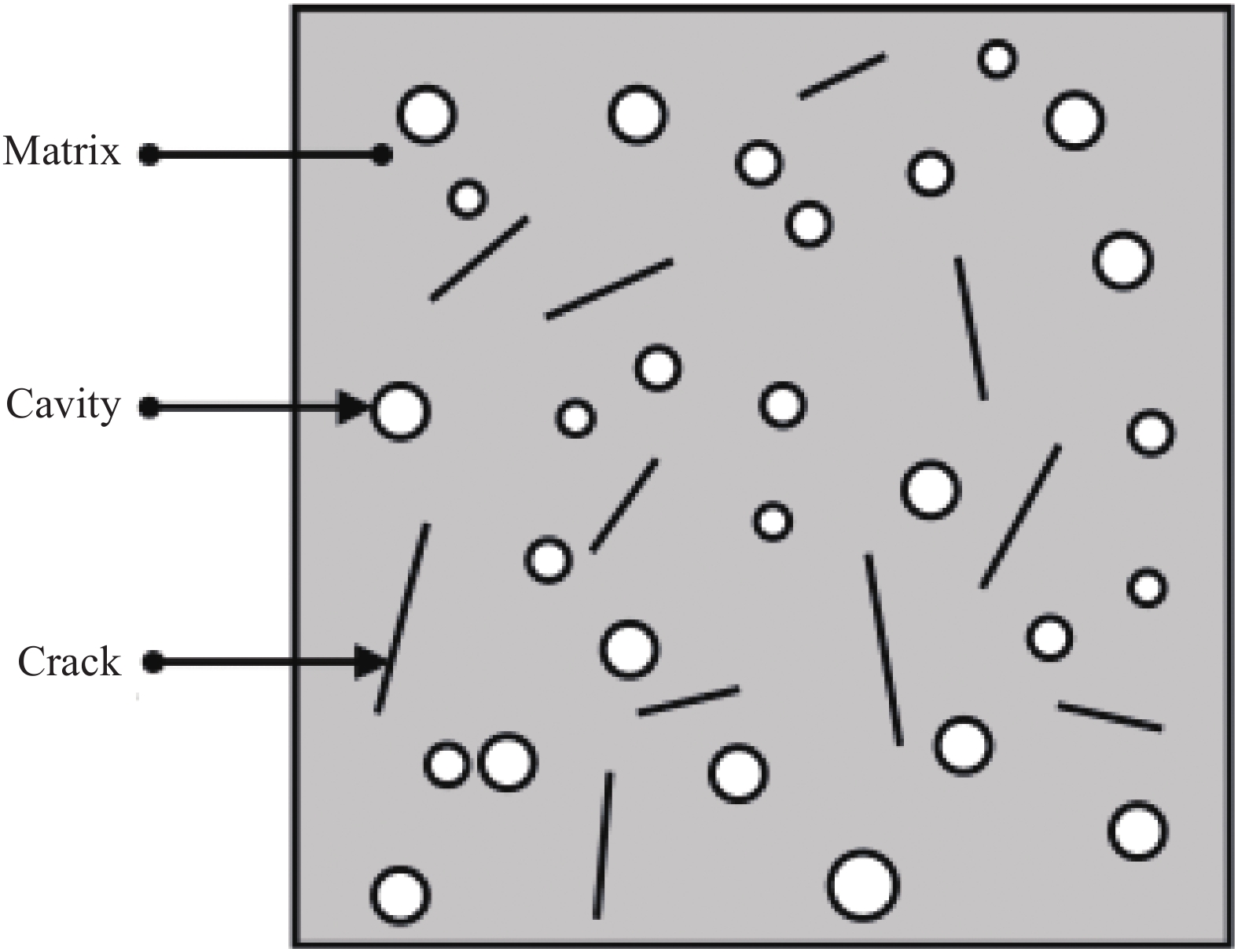| [1] |
陈则韶, 钱军, 叶一火. 复合材料等效导热系数的理论推算[J]. 中国科学技术大学学报, 1992, 22(4):416-424.CHEN Z S, QIAN J, YE Y H. Predicting theory of effective thermal conductivity of complex material[J]. Journal of University of Science and Technology of China,1992,22(4):416-424(in Chinese).
|
| [2] |
MAXWELL J C. A treatise on electricity and magnetism[M]. New York: Dover Publication, 1954: 16-20.
|
| [3] |
张伟平, 童菲, 邢益善, 等. 混凝土导热系数的试验研究与预测模型[J]. 建筑材料学报, 2015, 18(2):183-189. doi: 10.3969/j.issn.1007-9629.2015.02.001ZHANG W P, TONG F, XING Y S, et al. Experimental study and prediction model of thermal conductivity of concrete[J]. Journal of Building Materials,2015,18(2):183-189(in Chinese). doi: 10.3969/j.issn.1007-9629.2015.02.001
|
| [4] |
张伟平, 邢益善, 顾祥林. 基于细观复合材料的混凝土导热系数模型[J]. 结构工程师, 2012, 28(2):39-45. doi: 10.3969/j.issn.1005-0159.2012.02.007ZHANG W P, XING Y S, GU X L. Theoretical models of effective thermal conductivity of concrete based on composite materials in mesoscale[J]. Structural Engineers,2012,28(2):39-45(in Chinese). doi: 10.3969/j.issn.1005-0159.2012.02.007
|
| [5] |
姚秀鹏, 韩阳, 沈雷, 等. 高温后聚丙烯纤维增强水泥基复合材料导热的多尺度方法[J]. 复合材料学报, 2021, 38(10):3531-3542.YAO X P, HAN Y, SHEN L, et al. Multi-scale method for thermal conductivity of polypropylene fiber reinforced cementitious composites after high temperature[J]. Acta Materiae Compositae Sinica,2021,38(10):3531-3542(in Chinese).
|
| [6] |
王立成, 常泽, 鲍玖文. 基于多相复合材料的混凝土导热系数预测模型[J]. 水利学报, 2017, 48(7):765-772.WANG L C, CHANG Z, BAO J W. Prediction model for the thermal conductivity of concrete based on its composite structure[J]. Journal of Hydraulic Engineering,2017,48(7):765-772(in Chinese).
|
| [7] |
刘嘉涵, 徐世烺, 曾强. 基于多尺度细观力学方法计算水泥基材料的导热系数[J]. 建筑材料学报, 2018, 21(2):293-298. doi: 10.3969/j.issn.1007-9629.2018.02.019LIU J H, XU S L, ZENG Q. An investigation of thermal conductivity of cement-based composites with multi-scale micromechanical method[J]. Journal of Building Materials,2018,21(2):293-298(in Chinese). doi: 10.3969/j.issn.1007-9629.2018.02.019
|
| [8] |
ESHELBY J D. The determination of the elastic field of an ellipsoidal inclusion, and related problems[J]. Proceedings of the Royal Society of London, 1957, 241(1226): 376−396.
|
| [9] |
张研, 韩林. 细观力学基础[M]. 北京: 科学出版社, 2014: 78-90.ZHANG Y, HAN L. Foundation of mesomechanics[M]. Beijing: Science Press, 2014: 78-90 (in Chinese).
|
| [10] |
钟轶峰, 张亮亮, 周小平, 等. 复合材料热传导性能的变分渐近均匀化细观力学模型[J]. 复合材料学报, 2015, 32(4):1173-1178.ZHONG Y F, ZHANG L L, ZHOU X P, et al. Variational asymptotic homogenization micromechanics model for thermal conductivity of composites[J]. Acta Materiae Compositae Sinica,2015,32(4):1173-1178(in Chinese).
|
| [11] |
孙海浩, 石义雷, 刘伟强, 等. 随机结构复合材料等效导热系数的理论预测[J]. 复合材料学报, 2021, 38(9):2918-2926.SUN H H, SHI Y L, LIU W Q, et al. Theoretical prediction for effective thermal conductivity of composite materials with random structure[J]. Acta Materiae Compositae Sinica,2021,38(9):2918-2926(in Chinese).
|
| [12] |
张枫, 肖建庄, 宋志文. 混凝土导热系数的理论模型及其应用[J]. 商品混凝土, 2009(2):23-25, 51.ZHANG F, XIAO J Z, SONG Z W. The prediction models of thermal conductivity of concrete and their application[J]. Ready-Mixed Concrete,2009(2):23-25, 51(in Chinese).
|
| [13] |
唐世斌, 唐春安, 梁正召, 等. 混凝土热传导与热应力的细观特性及热开裂过程研究[J]. 土木工程学报, 2012, 45(2):732-747.TANG S B, TANG C A, LIANG Z Z, et al. Study of thermal conduction and thermal stress of concrete at mesoscopic level and its thermal cracking processes[J]. China Civil Engineering Journal,2012,45(2):732-747(in Chinese).
|
| [14] |
孙颖颖, 周璐瑶, 韩宇, 等. 气泡和气隙影响六方氮化硼/环氧树脂复合材料导热性能的有限元模拟[J]. 复合材料学报, 2020, 37(10):2482-2488.SUN Y Y, ZHOU L Y, HAN Y, et al. Numerical analysis of the effect of air bubbles and gaps on thermal conductivity of hexagonal boron nitride/epoxy composites[J]. Acta Materiae Compositae Sinica,2020,37(10):2482-2488(in Chinese).
|
| [15] |
李守巨, 刘迎曦, 于贺. 多孔材料等效导热系数与分形维数关系的数值模拟研究[J]. 岩土力学, 2009, 30(5):1465-1470. doi: 10.3969/j.issn.1000-7598.2009.05.049LI S J, LIU Y X, YU H. Numerical simulation of relationship between thermal conductivity of porous material and fractal dimension[J]. Rock and Soil Mechanics,2009,30(5):1465-1470(in Chinese). doi: 10.3969/j.issn.1000-7598.2009.05.049
|
| [16] |
SHAFIRO B, KACHANOV M. Anisotropic effective conductivity of materials with nonrandomly oriented inclusions of diverse ellipsoidal shapes[J]. Journal of Applied Physics,2000,87(12):8561-8569. doi: 10.1063/1.373579
|
| [17] |
ZHENG Q S, DU D X. An explicit and universally applicable estimate for the effective properties of multiphase composites which accounts for inclusion distribution[J]. Journal of the Mechanics and Physics of Solids,2001,49:2765-2788. doi: 10.1016/S0022-5096(01)00078-3
|
| [18] |
ZHOU C S, LI K F, PANG X Y. Effect of crack density and connectivity on the permeability of microcracked solids[J]. Mechanics of Materials,2011,43:969-978. doi: 10.1016/j.mechmat.2011.08.011
|
| [19] |
周春圣, 李克菲. 含裂纹夹杂多孔材料的渗透性理论与数值分析[J]. 工程力学, 2013, 30(4):150-156. doi: 10.6052/j.issn.1000-4750.2011.11.0753ZHOU C S, LI K F. Theoretical and numerical analyses of permeability of porous medium with cracking inclusions[J]. Engineering Mechanics,2013,30(4):150-156(in Chinese). doi: 10.6052/j.issn.1000-4750.2011.11.0753
|
| [20] |
HASHIN Z. Assessment of the self-consistent scheme approximation: Conductivity of particulate composites[J]. Journal of Composite Materials,1968,2(3):284-300. doi: 10.1177/002199836800200302
|
| [21] |
DU D X, ZHENG Q S. A further exploration of the interaction direct derivative (IDD) estimate for the effective properties of multiphase composites taking into account inclusion distribution[J]. Acta Mechanics,2002,157(1):61-80.
|
| [22] |
杨世铭, 陶文铨. 传热学[M]. 北京: 高等教育出版社, 2006: 15-36.YANG S M, TAO W Q. Heat transfer[M]. Beijing: Higher Education Press, 2006: 15-36 (in Chinese).
|
| [23] |
KACHANOV M. Effective elastic properties of cracked solids: Critical review of some basic concepts[J]. Applied Mechanics Reviews,1992,45 (8):304–335.
|
| [24] |
朱伯芳. 大体积混凝土温度应力与温度控制[M]. 北京: 中国电力出版社, 2012: 8-12.ZHU B F. Thermal stresses and temperature control of mass concrete[M]. Beijing: China Electric Power Press, 2012: 8-12(in Chinese).
|






 下载:
下载:

















